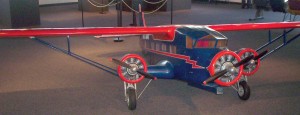By Fred “Crash” Blechman
The Santa Monica Museum of Flying has closed and Hawthorne’s Western Museum of Flight is threatened with closure. But a relatively little-known aviation museum, the Flight Path Learning Center-Museum, is growing at Los Angeles International Airport.

The Flight Path Learning Center Museum is located at the Imperial Terminal on the south side of LAX.
This small but active museum is tucked away at the Imperial Terminal on the south side of LAX, where chartered jets arrive and depart. Although no flyable aircraft are part of this museum, it contains many large aircraft models and holds frequent functions in its open spaces and many rooms. A huge panoramic picture window allows visitors to watch airplanes approaching all four LAX runways, as they listen to a radio set on the tower frequency.
The museum features models, photos, paintings, airline uniforms and other memorabilia. A panoramic mural salutes the 75th anniversary of LAX and Los Angeles World Airports as well as the Centennial of Flight. Other exhibits showcase development of airlines, aircraft, satellite technology and aviation firms. An original oil painting, “LAX–The Jet Age Airport,” by noted aviation artist Douglas Ettridge, depicts LAX in 1960, as the new terminals near completion. Other artwork shows the original concept of the arched LAX theme building. Several large paintings by Patrick J. Packard adorn the walls, showing aircraft from antiques and military, to past and current airliners.
A wall of honoree plaques at the museum entrance includes 45 past and present aviation legends, among them Charles “Chuck” Yeager, Tony LeVier, Donald Douglas, Bessie Coleman, Charles Lindbergh, Amelia Earhart, Clay Lacy, Bobbi Trout, the Wright brothers, Howard Hughes, John “Jack” Northrop, Kelly Johnson, Jimmy Doolittle, Glenn Martin, Dr. Sally Ride, Jacqueline Cochran, Juan Trippe and C.R. Smith.
A large-scale model of the last of aviation’s famous biplanes recently went on permanent public display. The Curtiss P-6E Hawk, modeled on a U.S. Army Air Corps aircraft manufactured in the early 1930s, is believed to be the only one of its kind at any museum in Southern California. The Hawk was built from scratch and donated by Chester M. Schmidt. It features an impressive six-foot, double-deck wingspan and authentic Army Air Corps colors, including a black, gray and white fuselage and yellow wings. The model, with a working engine, has been flown by remote control at hobbyist events. Another of the large models is one of a Stinson Model “U” tri-motor transport.
Recent events included a salute to the 100th birthday of Howard Hughes, a visit by members of the Tuskegee Airmen and a Veterans Day special for local American Legion members. The museum has also recently hosted an annual scholarship program and a fashion show saluting the 75th anniversary of the founding of the airline flight attendant service, as well as a gala that welcomed more than 350 dinner guests who were able to meet a number of aviation pioneers.
Flight Path was founded in 1995 as a nonprofit, community-based organization to honor aviation pioneers, recognize the economic importance of aviation and aerospace to Southern California, and encourage youth to pursue education and careers in aviation-related fields. The kickoff project was a series of sidewalk plaques in the LAX business district saluting aviation pioneers, organizations and locations–the aviation equivalent of the famed Hollywood Walk of Fame. Flight Path hosts an annual gala fundraising dinner when additional pioneers are honored and youth scholarships presented.

A large model of a 1932 Stinson Model U airliner, which carried a pilot and 10 passengers, is on the floor of the main room of the museum. Other rooms contain many models.
In November 2002, the Los Angeles Board of Airport Commissioners officially authorized Flight Path to operate an educational facility and museum in the LAX Imperial Terminal. During the following year, Flight Path refurbished the terminal with major support from Los Angeles World Airports, the agency that operates LAX. The initial focus of the facility, which opened in October 2003, was to celebrate the 75th anniversary of LAX and the 100th anniversary of the first powered flight by the Wright Brothers.
With the opening of the Learning Center, Flight Path now has an opportunity to reach thousands of residents and visitors to Los Angeles with historical exhibits, educational tours and programs, research facilities and community events. Flight Path is the only aviation museum and research center situated at a major airport, and the only facility with a primary emphasis on contributions of civil aviation to the history and development of Southern California.
The Flight Path exhibits gallery, filled with memories of aviation’s golden years, is adjacent to the LAX airfield, where today’s aircraft and travelers arrive and depart the world’s busiest origin and destination airport. No other museum offers such a perspective on contemporary aircraft and aviation.
There’s no admission charge to visit the Flight Path Learning Center. For hours of operation, directions and other information, call 310 215-5291.












